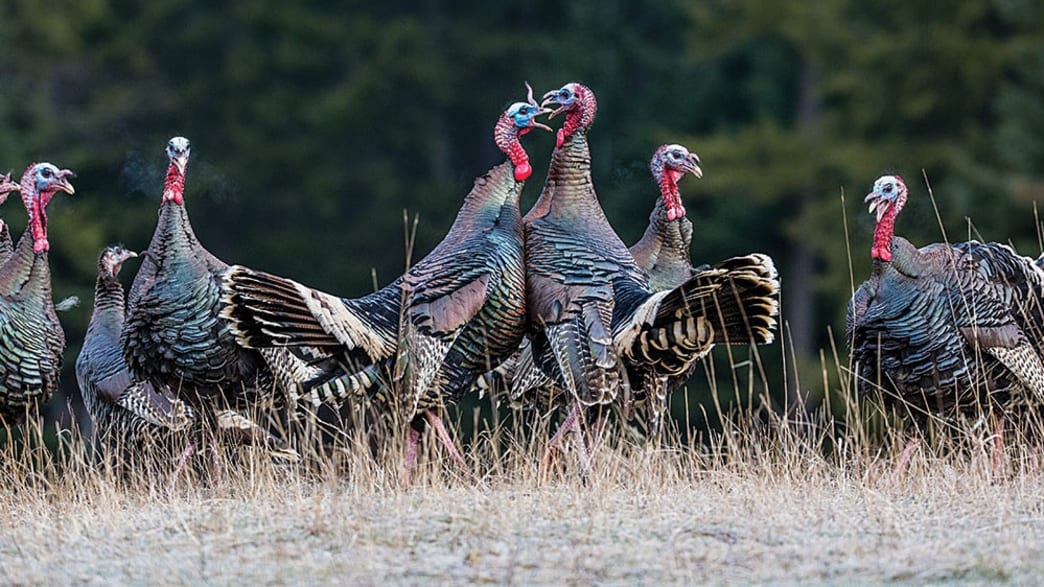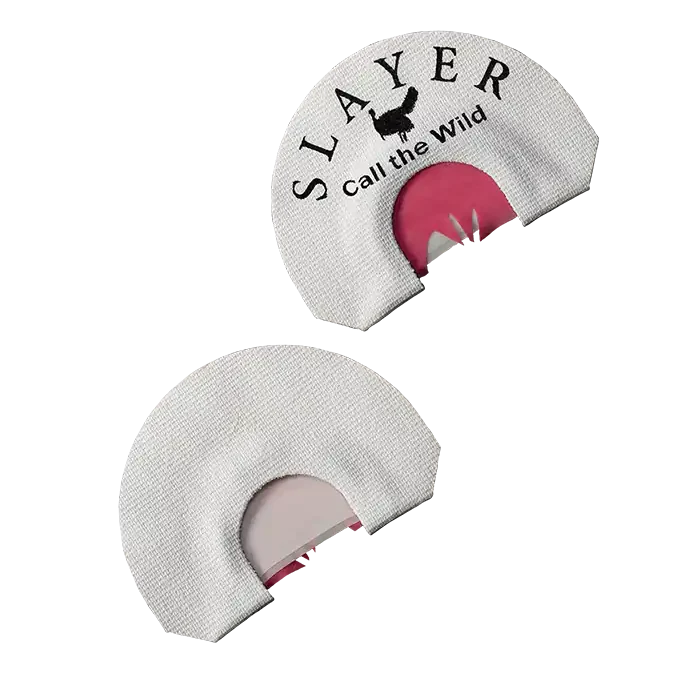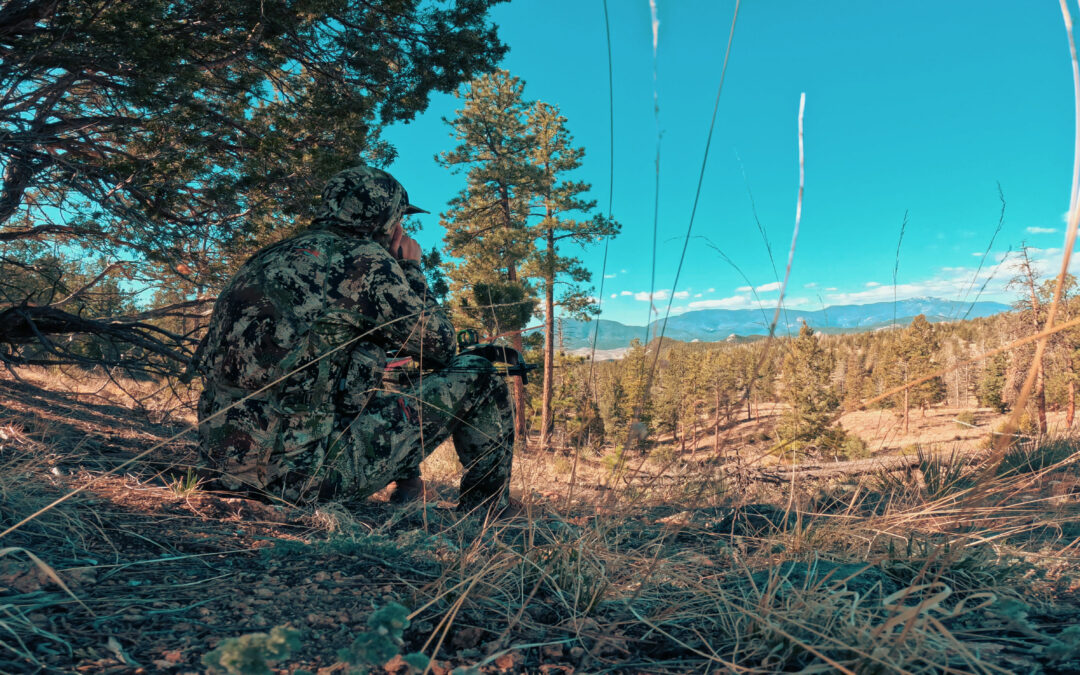
by Pursuit | Mar 2, 2024 | Hunting
Turkey hunting requires not only skill in tracking and concealment but also in understanding and mimicking turkey vocalizations. Mastering turkey sounds can significantly increase your success in the field. Here’s a guide to common turkey vocalizations and how to replicate them:
Gobble:
Description: The gobble is the most well-known turkey sound, typically made by male turkeys (gobblers) to attract hens and establish dominance.
How to Mimic: Inhale deeply and forcefully, then let out a burst of air while making a deep, guttural sound. Use a turkey call such as a box call, slate call, or mouth call to produce a realistic gobble.
Cluck:
Description: Clucking is a short, sharp sound made by both male and female turkeys. It’s used for communication within flocks and to maintain contact.
How to Mimic: Make a series of short, sharp, staccato sounds with your tongue against the roof of your mouth. You can also use a box call or mouth call to produce clucks.
Yelp:
Description: Yelps are the most common turkey vocalizations and are made by both males and females. They are used for communication within the flock and to locate one another.
How to Mimic: Make a series of clear, high-pitched notes with a rising and falling cadence. Use a box call, slate call, or mouth call to replicate yelps accurately.
Purrs:
Description: Purrs are soft, rolling sounds made by turkeys when they are content or feeding. They can also be used as a reassuring sound.
How to Mimic: Purrs are best mimicked by softly rolling your tongue against the roof of your mouth while exhaling gently. You can also use a friction call like a slate call to produce purring sounds.
Kee-kee:
Description: The kee-kee is a high-pitched, whistling sound made by young turkeys (poults) to maintain contact with each other or when they are lost.
How to Mimic: Make a series of high-pitched, whistle-like notes with a descending cadence. Mouth calls are often used to mimic kee-kees effectively.
Tips for Effective Turkey Calling:
1. Practice Regularly: Mastering turkey calls takes practice, so spend time practicing different calls until you can produce realistic sounds.
2. Start Soft: Begin your calling sequences softly, gradually increasing volume and intensity as needed.
3. Use Realism: Pay attention to the cadence, rhythm, and pitch of turkey sounds, and try to replicate them as accurately as possible.
4. Call Sparingly: Avoid overcalling, as this can spook turkeys. Call only when necessary to keep the birds interested and engaged.
5. Stay Concealed: Always ensure you’re well-concealed while calling to avoid being detected by wary turkeys.
By mastering these turkey sounds and using them effectively in the field, you’ll significantly increase your chances of success while turkey hunting.

by Pursuit | May 16, 2023 | Hunting
Turkey patterns constantly change during the Spring season, knowing what those are and what they might mean for your hunt can be critical in filling that tag. During the final week of May, turkeys may exhibit specific behaviors due to various factors, including breeding activity, weather conditions, and hunting pressure. Here are some key behaviors to consider during this time:
1. Breeding activity: By late May, the turkey breeding season is typically winding down, but there may still be some late-nesting hens and active gobblers. Toms might continue to gobble, but their response to calls may be less enthusiastic compared to earlier in the season. However, if you come across receptive hens, gobblers may still be in pursuit.
2. Roosting patterns: Turkeys generally maintain consistent roosting patterns, and during the final week of May, they may still be using the same roost sites as earlier in the season. Pay attention to where turkeys roost, as it will help you plan your morning setups.
3. Feeding routines: Turkeys will continue to feed throughout the day, with a focus on replenishing their energy reserves after the breeding season. Identify preferred feeding areas such as open fields, agricultural fields, or mast-producing trees. Turkeys will often travel to these locations during the late morning or early afternoon.
4. Increased wariness: As the season progresses and turkeys have experienced hunting pressure, they tend to become more cautious and wary of calls and decoys. They may be less responsive to aggressive calling and exhibit more skepticism towards decoys. Using subtle and realistic calling techniques can be more effective.
5. Adjusting to weather conditions: Weather can play a significant role in turkey behavior during late May. If the weather is warm, turkeys may adjust their activity patterns and feed more during cooler hours. Rainy or windy conditions may limit their movement and make them more likely to seek sheltered areas.
6. Changing habitat preferences: By late May, turkeys may alter their habitat preferences. They might move from dense cover used during the breeding season to more open areas, such as fields or edges of woodlands. Consider scouting to identify these transitional areas.
7. Hunting pressure impact: Turkeys that have experienced hunting pressure throughout the season can become more difficult to hunt. They might move to less-accessible areas, become more nocturnal, or change their patterns altogether. Adjust your hunting strategies accordingly, such as hunting quieter or less-pressured locations.
Observing turkey behavior in your specific hunting area during the final week of May is crucial. Spend time scouting, noting any changes in turkey activity, and adjust your hunting techniques accordingly. Adapting to their behavior patterns can increase your chances of a successful hunt during the closing days of the season.

by Pursuit | Apr 20, 2023 | Gear, Hunting
Slayer Calls Turkey Mouth Calls are an exceptional product for turkey hunters looking for an effective and reliable way to attract game. The quality of the materials and craftsmanship is immediately apparent upon first inspection, with each call featuring precision-cut latex reeds and a durable aluminum frame.
One of the standout features of these mouth calls is their versatility. The set includes three different calls, each with its unique tone and pitch, allowing hunters to experiment and find the perfect sound to draw in their target. The calls are also easy to use, making them a great choice for both beginners and experienced hunters.
In terms of performance, Slayer Calls Turkey Mouth Calls deliver excellent sound quality. The calls produce a realistic turkey sound that is sure to grab the attention of nearby game. Additionally, the calls are designed to be durable and long-lasting, ensuring that they will hold up to repeated use in the field.
Overall, I would highly recommend Slayer Calls Turkey Mouth Calls to any turkey hunter looking for a high-quality product that delivers on both performance and durability. These calls are an excellent investment for anyone who takes their turkey hunting seriously.
Buy Now

by Pursuit | Apr 13, 2023 | Hunting
There are numerous locations for spring turkey hunting across the United States, each with their own unique characteristics and challenges. Here are some of the top locations to consider.
Texas: Texas is a top destination for turkey hunting, with an abundance of Eastern and Rio Grande turkeys spread throughout the state. The terrain varies from rolling hills to open prairies, providing hunters with a diverse range of hunting opportunities.
Florida: Florida is known for its Osceola turkeys, which can only be found in the state. The hunting season is relatively long, and the birds can be found throughout the state’s varied landscapes, including forests, swamps, and agricultural areas.
Kansas: Kansas is home to both Eastern and Rio Grande turkeys, with a healthy population of birds spread throughout the state. The terrain ranges from grasslands to wooded hills, providing hunters with a variety of hunting opportunities.
Missouri: Missouri is known for its abundant population of Eastern turkeys, which can be found throughout the state’s wooded hills and river valleys. The state offers a long hunting season, and hunters are allowed to harvest two birds per season.
Alabama: Alabama is home to Eastern turkeys and has a relatively long hunting season. The state offers a diverse range of terrain, including forests, hills, and agricultural areas, providing hunters with plenty of hunting opportunities.
South Carolina: South Carolina is home to Eastern turkeys and offers a long hunting season. The state’s varied terrain includes mountains, forests, and agricultural areas, providing hunters with a range of hunting opportunities.
Ultimately, the best spring turkey hunting location depends on your personal preferences and hunting style. Be sure to do your research and choose a location that offers the type of hunting experience you’re looking for.�

by Pursuit | Nov 2, 2022 | Hunting, Inside Pursuit
Served with a side of charred cabbage, this riff on a classic spring dish is a gobbler game-changer
This turkey isn’t technically “corned,” or preserved, but a three-day steep in a pickling-spice-infused brine gives it the unmistakable tang of corned beef, that springtime staple. The ultra-gentle poaching technique—cooking the meat at less than a simmer—yields lush, juicy turkey breast, with just a blush of pink at the center. With a crispy, smoky finish, the charred vegetable amps up the springtime feel. Adapted from a recipe by the Sicilian-born chef Christian Puglisi, this slightly crazy method of cookery treats cabbage like a steak, producing a seared, flavorful edge and a tender center. Carrots with parsley or roasted potatoes would nicely round out this dish.
Ingredients | Serves 4
For the Corned Turkey
- 1 boneless, skinned wild turkey breast half (2 to 31⁄2 lb.)
- 1 cinnamon stick, broken into pieces
- 3 cloves
- 3 bay leaves, torn into pieces
- 2 Tbsp. mustard seeds
- 2 Tbsp. coriander seeds
- 1 Tbsp. celery seeds
- 1 Tbsp. fennel seeds
- 1 Tbsp. juniper berries, crushed
- 1 Tbsp. black peppercorns
- 1 Tbsp. red pepper flakes
- 1 tsp. dried thyme
- 1⁄2 cup salt
- 2 Tbsp. brown sugar
- 4 garlic cloves, smashed
- 1 slice fresh ginger, about the size of a quarter
For the Vinaigrette
- 1 Tbsp. whole-grain mustard
- 2 Tbsp. apple cider vinegar, divided
- 1⁄2 small shallot, minced
- 1⁄4 cup extra-virgin olive oil
- 1⁄8 tsp. liquid smoke
For the Cabbage
- 1⁄2 head of cabbage
- 1 Tbsp. vegetable oil
- 3 Tbsp. unsalted butter
- Kosher salt and freshly ground black pepper, to taste
Steps to Make Corned Wild Turkey Breast
- Make the pickling spice: Combine the cinnamon stick, cloves, bay leaves, mustard seeds, coriander, celery, fennel, juniper, peppercorns, red pepper flakes, and thyme in a small bowl, and use your fingers or a fork to mix the spices evenly.
- Make the brine: Bring 4 cups water to a boil in a medium pot. Add the 1⁄2 cup salt, brown sugar, garlic, ginger, and 2 tablespoons of the pickling spice. (You’ll have some left over.) Stir until the salt and sugar dissolve, then allow the mixture to cool fully. Once it’s cooled, place the turkey breast and the brine in a sealable plastic bag. (The bones can puncture a bag, so double-bagging—or keeping the bag inside a bowl—is recommended.) Brine the turkey in the refrigerator for three to four days, turning the bag daily.
- Bring a large pot of water to boil. Remove the turkey from the brine and rinse thoroughly under cold running water, brushing off most of the spice mix. Slide the turkey into the pot, and turn the heat to its lowest setting. You want the meat to cook at less than a simmer, just a very gentle poach. Cover and check the meat with an instant-read thermometer after 45 minutes. When the thermometer reads 150 degrees at the thickest part, transfer the breast to a cutting board.
- While the turkey is poaching, make the vinaigrette: Whisk together the mustard, 1 tablespoon of the vinegar, and the shallot in a small bowl. Whisking all the while, drizzle the olive oil into the bowl until the mixture is smooth and emulsified. Stir in the liquid smoke, season with salt and pepper, and set aside.
- Char the cabbage: Set a cast-iron skillet over high heat. Add the oil, and then add the cabbage half, cut-side down. Sear the cabbage, without disturbing it, for about 13 minutes. (If you have a vent hood, turn it on; the cabbage will smoke.)
You’re looking for a profoundly blackened surface, so don’t worry about burning it. Turn the cabbage over and reduce the heat to medium-low. After a few minutes, add the butter. Once it’s melted, use a spoon to baste the blackened side of the cabbage with it, tilting the pan to get as much butter as possible. Cook this way, basting every few minutes or so, for a total of 15 to 20 minutes, or until there’s little resistance when you pierce the cabbage with a knife or skewer. Turn off the heat. Baste the cabbage with any butter remaining in the pan, then sprinkle the remaining tablespoon of vinegar over the top. Salt and pepper generously.
To serve, slice the corned turkey breast and fan the slices on four plates. Divide the cabbage into four wedges, and lightly drizzle the vinaigrette over the cabbage and the turkey breast. Serves 4
Written by Jonathon Miles for Field & Stream and legally licensed through the Matcha publisher network. Please direct all licensing questions to legal@getmatcha.com.
Featured image provided by Field & Stream





